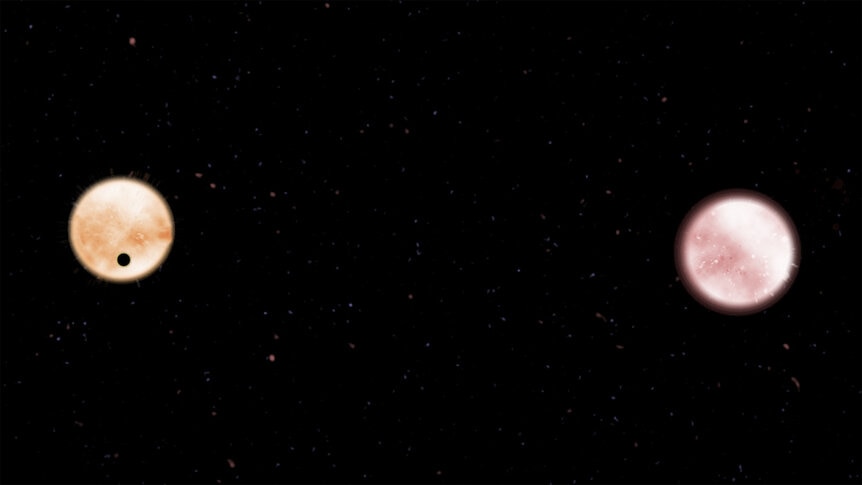Create a free profile to get unlimited access to exclusive videos, sweepstakes, and more!
Another Tatooine-like exoplanet found orbiting a binary star
Planet found orbiting a binary with two Sun-like stars.

Astronomers have found a new exoplanet in a fairly weird way — not because of its orbital motion around its host star, as is usually the case, but because of the motion of its host stars around each other. Yes, stars, plural, because it orbits two stars that orbit each other.
Two stars orbiting each other are called binary stars, and a planet that orbits them both is called a circumbinary planet. Quite a few are known now.
Sometimes we see the binary stars' orbit edge on, so that they pass in front of one another from our viewpoint twice per orbit (first star A blocks star B, then half an orbit later B blocks A). We call these eclipsing binaries.
In a paper that was co-written by apparently every exoplanet astronomer in existence (I tease, but whoa that's a long author list; indicative of how much work went into this discovery), they present a planet orbiting the eclipsing binary TIC 172900988. This star system is about 800 light years away in the constellation Cancer. The planet, called TIC 172900988b, was discovered in observations by TESS, the Transiting Exoplanet Survey Satellite, a NASA mission that observed the entire sky looking at brighter, nearby stars for planets. If we see a planet's orbit edge-on, it will pass in front of ("transit") its host star and block a bit of its light. By observing stars at a high cadence, over and again, TESS can catch these transits as a slight dimming of the star.
As it orbits Earth TESS observes the sky in sectors, like orange peel slices, and each one of the 13 sectors is watched for about 27 days. It observed TIC 172900988 from January 21 to February 18, 2020. During that time it saw the two stars eclipse twice, and from that an orbital period of about 19.7 days was determined. That's a short orbit, which means the stars are fairly close together, separated by less than 30 million kilometers (about half the distance of Mercury from the Sun).
When the stars eclipse each other there's a big drop in light from the system, about 35% — we don't see the binary exactly edge on, so each eclipse is partial. But, combined with other observations of the stars from different observatories, more can be learned about them.
Given the way they eclipsed and the duration, the masses and sizes of both stars could be determined. Star A is about 1.24 times as massive as the Sun, with a radius of 1.38 Suns. The second star, B, has a mass of 1.2 Suns and a radius of 1.31. They're not identical, but pretty close (which is common in binary stars; they form together and tend to grow at the same rate), and fairly similar to the Sun. They orbit each other on a relatively elongated ellipse (for those who like details, their orbital eccentricity is 0.45, where e=0 is a circle and e=1 is an infinitely long line).
The thing is, TESS also saw two other dips in the light, much shallower at about 0.3%. That was from the planet transiting… first one star, then the other! Because the sizes of the stars are known, the depth of the transit allows the size of the planet to be found, and it's almost exactly the same size as Jupiter (about 11 times wider than Earth).
It gets better. Because the stars are bright in Earth's sky, lots of telescopes have observed them over time. Examining archived data, the astronomers found the binary stars' orbit around each other has changed direction, what's called apsidal precession. The orbit is an ellipse, and the line drawn through the long dimension is called its major axis. If the stars were alone in space that axis would always point in the same direction. However, the timing of the eclipses has slowly changed, meaning the axis of the ellipse is slowly rotating in space. This is due to the planet tugging on the stars, gravitationally interacting with them as it orbits. That allows the mass of the planet to be found (the greater the mass, the harder it tugs), and it's between 2.85 and 3.1 times Jupiter's.
The orbital period of the planet is a bit hard to pin down; modeling its behavior yields six different orbital solutions that are all equally likely, which is a bit unusual. But the period is between 189 and 204 Earth days. The orbit is pretty nearly a circle, and the planet is about 135 million kilometers out — slightly smaller than Earth's orbit around the Sun. That means this beefy planet, certainly a gas giant like Jupiter and Saturn, is hotter than Earth.
That makes me wonder if it has moons, maybe even planet-sized ones (Jupiter's Ganymede and Saturn's Titan are both about as big as Mercury, after all). At that distance from the stars, they'd be pretty warm but maybe not too warm for habitability. Just a thought, an aside, but hmmm.
Also, it's too bad it's a gas giant: Given the two stars being very Sun-like and close together, this would make a great candidate for a real-life Tatooine! Canonically, Luke Skywalker's homeworld orbits a binary star system with two Sun-like stars that are in a tight orbit, and given it's a desert planet it's likely warmer than Earth, too. Oh well. Maybe instead it's Ohann. Either way, if we're looking for a wretched hive of scum and villainy, we'd better keep searching.
Anyway, the point is that the orbital period of the planet (its "year") is much longer than the period of the stars, so the stars are going around each other much faster than the planet around them both. Since two transits were seen, this means they were due more to the stars moving more than the planet. That's a little funny to think about.
It also means the transits will come at weird intervals. Normally, when a planet orbits a single star, the transits come in regular intervals equal to the orbital period of the planet. But this one orbits a binary, and those two stars are moving as well. So it might first transit star A and then B a few days later, but then next orbit it might transit B first and then A. And the time between the two stellar transits might change if the two stars are closer together or farther apart when we happen to see the planet transit. It's a bit of a mess.
This is the first circumbinary planet to be found in such an unusual way. And given the stars are close to Earth and bright it means a lot of follow-up observations can be made to learn even more about it. Circumbinary planets are really interesting — whether you're a Star Wars fan or not — and the more we learn about them the more we find out about how planets are born, how they change over time and, in this case, even how they affect their host stars. They're far more than just a fLuke of nature.

















